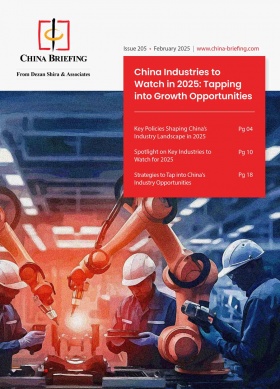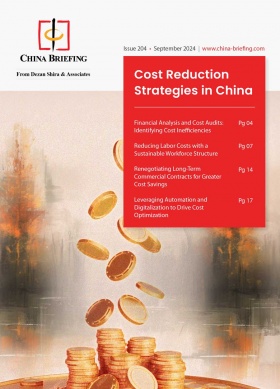The Policies Shaping China’s Industry Landscape in 2025
China’s policy-driven initiatives will shape its industrial trajectory in 2025, driving growth through domestic demand, innovation, and sustainability. Businesses and investors must adapt to these shifts and take note of emerging opportunities across key sub-sectors.
2025 marks the final year of the 14th Five-Year Plan, signaling a critical phase in the country’s development. Seeking to finalize the tasks set out in this plan, the country will shift focus to expanding domestic demand, stabilizing growth, and managing risks, while pushing forward structural reforms to drive industry upgrading. At the same time, China’s government is expected to leverage fiscal, monetary, and industry policies to steer growth in strategic sectors.
To support these goals, China plans to implement extraordinary fiscal measures, including increasing the fiscal deficit ratio to between 3.5 and 4 percent, issuing ultra-long-term special treasury bonds and special-purpose bonds, and focusing on supporting infrastructure, manufacturing technology transformation, and New Quality Productive Forces (NQPFs). On the monetary side, policies will shift toward “moderate easing”, with anticipated interest rate cuts and reserve requirement ratio reductions to ease financing pressures on businesses. Green technologies, high-end manufacturing, and the digital economy will be prioritized for investment, offering significant opportunities for growth in these fields.
Equally important is China’s focus on stimulating domestic consumption. In 2025, policies will aim to boost consumer spending through more targeted measures, enhancing mechanisms for consumption growth and continuing to expand sectors like cultural tourism and healthcare. The integration of e-commerce, culture, and tourism is also expected to play a crucial role in driving long-term consumption growth, as well as the improvement of conditions and incomes for rural communities through the rural revitalization drive.
For businesses, these policy priorities provide a useful blueprint for growth in 2025. With government backing for industries related to the green transition, digital transformation, high-end manufacturing, and emerging technologies, there will be ample opportunities for firms that can adapt to these evolving directives and leverage the support provided.
Expanded market access through foreign investment and industry catalogues
One of the strategies China employs to manage foreign investment in domestic industries is the implementation of negative lists and encouraged industry catalogues to restrict and promote foreign investment in key industries. These documents, which are updated every few years, are one of the government’s key tools to increase market access for foreign companies in China. The country also has several “industry catalogues” that guide government support and incentives toward priority fields and industries.
Foreign investment negative list and other pilot programs
The Foreign Investment Negative List (officially, The Special Management Measures for Foreign Investment Access (Negative List)) outlines the fields that are either subject to foreign ownership caps or completely off-limits for foreign investment. This means foreign and domestic companies have equal access to all fields not included in this list. The 2024 Negative List, which came into effect on November 1, 2024, removed two items from the previous version, both in manufacturing. There are now only 29 fields that are restricted or prohibited from foreign investment, and restrictions on foreign investment in the manufacturing sector have been completely removed.
Moreover, a State Council meeting held in August 2024 emphasized that China will “further relax foreign investment access […] accelerating the opening of the telecommunications, education, and healthcare service sectors”. Following this, in September 2024, the Ministry of Commerce published a circular announcing the expansion of pilot programs for opening up the medical sector. This circular lifts bans on foreign-invested enterprises engaging in cell and gene therapy in selected free trade zones and permits wholly foreign-owned hospitals in selected cities.
Moreover, in late October 2024, China officially launched a pilot program to remove the longstanding 50 percent foreign ownership cap on data centers and other value-added telecom services, allowing for full foreign ownership in the sector in selected cities.
Foreign investment encouraged catalogue
Meanwhile, the Catalogue of Encouraged Industries for Foreign Investment (hereinafter, the “FI Encouraged Catalogue”) outlines the industries in which FDI is welcomed and treated with favorable policies. The catalogue is split into two subcategories: the “national catalogue”, which lists industries that are promoted nationwide, and the “regional catalogue” listing encouraged industries in China’s central, western, and northeastern regions.
The 2024 version FI Encouraged Catalogue was released in draft form in December 2024. While the finalized version is yet to be released, the draft version contains a total of 1,700 items, with 620 items in the national catalogue and 1,080 in the regional catalogue. This is an overall increase of 15 percent from the 2022 version, suggesting a significant expansion in support for foreign investment.
The added industries lean heavily toward key emerging sectors, including high-performance equipment manufacturing, energy-saving technologies, low-carbon solutions, automation, and the development of innovative technologies like generative AI. In addition, the catalogue highlights areas such as healthcare, education, new energy utilization, and sectors related to societal well-being, such as pet care, elderly care, and cultural tourism.
Currently, the FI Encouraged Catalogue provides benefits such as tariff exemptions on certain eligible imported equipment, as well as access to land at reduced rates, with the land transfer reserve price set as low as 70 percent of the national minimum price for industrial land transfers. Meanwhile, for projects operating in the western regions of China and Hainan province, the catalogue enables foreign investors to benefit from a significantly reduced corporate income tax rate of 15 percent, provided they meet certain requirements.
Green industry catalogue
The 2024 edition of the Catalogue of Industries for Green and Low-carbon Transition (hereinafter referred to as the “2024 Green Industry Catalogue”), a new iteration of the 2019 Green Industry Catalogue, serves as a key reference for advancing China’s green sectors. Released in February 2024, the new catalogue provides updated classifications and definitions of green industries, helping policymakers, businesses, and investors allocate resources effectively. It will also serve as a key policy tool for developing eco-friendly industries and achieving China’s carbon and environmental goals in 2025.
Notably, the 2024 Green Industry Catalogue broadens its focus to include decarbonization, as reflected in its renamed title. The updated catalogue expands its coverage to seven categories and adds 22 new items, focusing on several key fields: energy saving and carbon reduction, environmental protection, recycling, clean energy, ecological protection and restoration, green infrastructure upgrading, and green services. It also adds several new industries, including areas such as logistics, information technology infrastructure, and various market segments along the hydrogen energy supply chain.
The catalogue also notably broadens its scope to focus on fields that will directly help with the low-carbon transition. These include technologies related to greenhouse gas controls, such as carbon dioxide capture, utilization, and storage (CCUS) and the development and utilization of substitutes for ozone-depleting substances. Other notable fields include the R&D, certification, and promotion of green technology products, as well as air, water, and soil pollution control.
Amid China’s pursuit of a cleaner environment and “dual carbon” targets—achieving peak emissions by 2030 and carbon neutrality by 2060—the catalogue provides an important roadmap for stakeholders by clearly defining the priority areas within the green industries. This in turn provides myriad opportunities for foreign enterprises, who will be able to better target investments in sectors that benefit from supportive policies, such as tax incentives, tariff exemptions, and access to green finance.
Advancing emerging industries through the New Quality Productive Forces economic model
A new term in China’s policy landscape, NQPFs represent an innovation-driven economic model that leverages emerging and disruptive technologies to create new industries, economic structures, and social systems. These “forces” will in turn also transform traditional industries through digitization, increased connectivity, and intelligent upgrades. Closely tied to the concepts of “new industries” and “new-type industrialization,” NQPFs aim to achieve technological self-sufficiency, industrial modernization, and bolster China’s global competitiveness in frontier sectors and high-tech industrial value chains.
The importance of NQPFs was evident during the 2024 Central Economic Work Conference in December, which highlighted these fields as critical to modernizing China’s industrial system. The agenda emphasized innovation-driven growth, focusing on fundamental research, breakthroughs in core technologies, and scaling up applications of new products, technologies, and scenarios.
The conference also called for more social capital participation in venture capital, the cultivation of innovative enterprises, and the active use of digital and green technologies to transform and upgrade traditional industries.
Although NQPFs remain an emerging concept and the central government has yet to issue targeted incentive policies, local governments are spearheading initiatives to support the growth of related industries. For instance, the Lingang New Area in the Shanghai Pilot Free Trade Zone introduced policies in 2024 to develop advanced computing power, deemed essential for enabling NQPFs. Measures include subsidies of up to RMB 10 million (US$1.41 million) for building intelligent computing centers, green computing projects, and using autonomous computing chips. Additionally, technological innovation vouchers are offered to small and medium-sized enterprises (SMEs).
Despite a focus on self-sufficiency, China has explicitly acknowledged the role of foreign investment in developing NQPFs. The government encourages private equity, venture capital, and angel investment in this area, with a key policy document passed during the 2024 Third Plenum in July emphasizing the inclusion of foreign capital. Additionally, the Chinese People’s Political Consultative Conference (CPPCC) highlighted the role of foreign investment in the development of NQPFs in an explainer released that same month, calling for “using foreign technology, funds, and talent, and encouraging Chinese enterprises to carry out various forms of cooperation with foreign enterprises”.
The Ministry of Science and Technology has also established three think tanks, including the International Science and Technology Promotion Center, which seeks to expand China’s engagement in global science and technology governance and foster international collaboration. With the government actively advancing these innovative industries, NQPFs offer foreign investors a promising avenue for collaboration and growth in 2025.
Developing new markets through rural revitalization
China’s rural revitalization initiative is a central government policy aimed at fostering economic growth by transforming rural areas, where over 477 million people still live as of 2023. This strategy seeks to address the disparities between urban and rural regions, ensuring that the benefits of modernization and development are shared across the entire nation. By focusing on enhancing agricultural productivity, improving infrastructure, and elevating the quality of life for rural residents, the initiative aims to create a more balanced and equitable socio-economic landscape while unleashing consumption and driving economic growth.
In January 2025, the Central Committee of the Communist Party of China and the State Council released the Rural Comprehensive Revitalization Plan (2024-2027), which outlines various goals and tasks to boost the rural economy and society by 2027. These include strengthening food security through increased agricultural output, narrowing the income gap between urban and rural residents, and promoting sustainable farming practices to align with the country’s environmental objectives. The plan also emphasizes the development of rural infrastructure and public services, aiming to create livable and prosperous rural communities.
The focus on modernizing agriculture and enhancing food security creates demand for advanced technologies and solutions that can improve productivity and resource efficiency. Areas such as smart farming, automated irrigation, and environmentally friendly agricultural methods are particularly relevant to the plan’s goals. Opportunities also exist in agriculture machinery and technologies that support sustainable farming practices, as well as digitized and smart crop solutions that maximize the utilization and output of limited arable land.
With rural infrastructure development being another critical component of the revitalization plan, there are also many prospects for participation in modernizing rural water supply systems, energy grids, and waste management infrastructure, among others. For example, water conservation technologies, rural sanitation systems, and renewable energy applications could still see targeted opportunities in underserved regions.
The healthcare sector also features prominently in the plan, with a focus on strengthening rural healthcare systems and expanding access to medical services. This presents new opportunities to improve facilities, expand drug access, and introduce advanced healthcare technologies through services such as telehealth, rural pharmaceutical distribution, and diagnostic solutions.
Conducting business in China under Trump 2.0
A significant concern for businesses operating in China is the fallout from a potential US-China trade war. Since returning to office on January 20, 2025, Trump has followed through on his pledge to impose various tariffs on major trade partners, including Canada and Mexico.
At the time of writing, however, he has not yet imposed the sweeping 60 percent tariff on all Chinese-made goods that he threatened during his campaign. As of March 4, 2025, the tariff rate has reached 20 percent, up from the initial 10 percent rate imposed on February 4. Seemingly prepared for such measures, China responded to the initial 10 percent tariff with duties of 15 percent on US coal and liquefied natural gas and 10 percent on crude oil, agricultural machinery, large-displacement cars, and pickup trucks. After Trump raised the rate to 20 percent, China countered with duties of 10 and 15 percent on various US agricultural products, including cotton, wheat, corn, sorghum, chicken, and soybeans.
China has seperately implemented export restrictions on critical minerals, such as tungsten, tellurium, bismuth, and molybdenum, which are essential to a range of products and manufacturing processes.
Besides the tariffs on Chinese imports, Trump has imposed various other duties that will directly and indirectly impact China. On February 10, Trump announced a further 25 percent tariff on all steel and aluminum imports into the US. While China exports only a limited amount of steel and aluminum directly to the US, the broad scope of the tariff means that re-exports of Chinese goods through third countries will also be affected. This is likely to have a much greater impact on China’s domestic industries and will pose significant challenges to global supply chains.
China’s response thus far has been measured, targeting a relatively small range of US imports, suggesting the government is leaving the door open for negotiation. However, the targeting of ageicultural products is significant; China is one of the world’s largest importers of agricultural products and a major buyer of US soybeans, corn, and sorghum. Agricultural products were a core component of the trade deal struck between China and the Trump administration in 2019, which saw China commit to purchasing around US$200 billion in agricultural goods from the US over a two-year period. Agriculture will therefore play an important role in any potential trade negotiations.
The extent to which Trump will escalate tariffs on Chinese goods—and how China might respond—remains uncertain. What is clear, however, is that the Trump administration will oversee considerable volatility and uncertainty in global markets, with major implications for businesses operating in China.
A potential escalating US-China trade war is likely to drive significant changes in global business operations and trade patterns. Rising production costs due to tariffs on imports and exports could push companies to adjust their pricing strategies, potentially leading to higher consumer prices or slimmer profit margins.
For industries reliant on critical materials and products impacted by the tariffs and export controls, supply chain delays and cost increases may become more frequent, impacting production schedules and product availability.
To address these challenges, businesses are likely to focus on building more resilient supply chains and identify alternate suppliers within existing regions or sectors. Flexibility in sourcing materials and components will help companies manage the effects of tariffs and maintain continuity in production.
Localized production may also become more prevalent as a means of avoiding tariffs, causing manufacturing hubs to move closer to key consumer markets. It may also accelerate the trend of reshoring to countries with lower production and labor costs to offset the increased cost of business, as well as investments in automation and technology.
Read more: US-China Relations in the Trump 2.0 Era: A Timeline
Leveraging government policies for growth in 2025
In 2025, China’s policy-driven initiatives will play a pivotal role in shaping its industrial trajectory. For businesses and investors, understanding and adapting to these policy shifts will be essential. Those who can navigate the evolving regulatory landscape and capitalize on government-backed growth areas will find lucrative opportunities for collaboration and expansion in the China market.
(This article was originally included in the China Briefing Magazine, “China Industries to Watch in 2025 Tapping into Growth Opportunities“, and was republished on March 10 with latest developments.)
About Us
China Briefing is one of five regional Asia Briefing publications, supported by Dezan Shira & Associates. For a complimentary subscription to China Briefing’s content products, please click here.
Dezan Shira & Associates assists foreign investors into China and has done so since 1992 through offices in Beijing, Tianjin, Dalian, Qingdao, Shanghai, Hangzhou, Ningbo, Suzhou, Guangzhou, Haikou, Zhongshan, Shenzhen, and Hong Kong. We also have offices in Vietnam, Indonesia, Singapore, United States, Germany, Italy, India, and Dubai (UAE) and partner firms assisting foreign investors in The Philippines, Malaysia, Thailand, Bangladesh, and Australia. For assistance in China, please contact the firm at china@dezshira.com or visit our website at www.dezshira.com.
- Previous Article EU-China Relations After the 2024 European Elections: A Timeline
- Next Article China vs. US Economy: Comparative Analysis and 2025 Outlook









